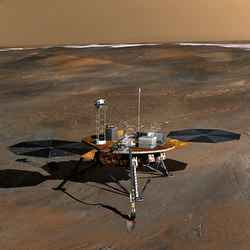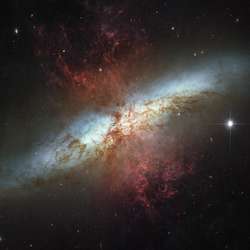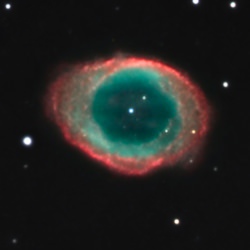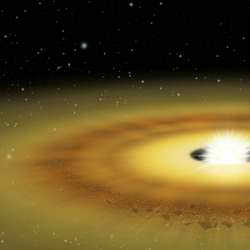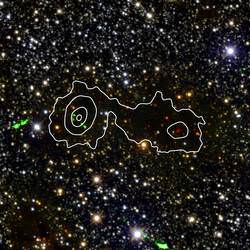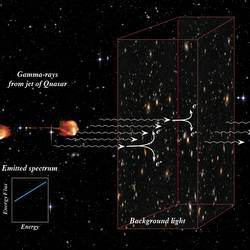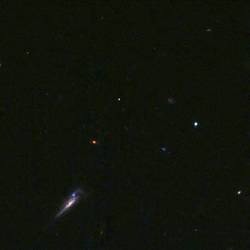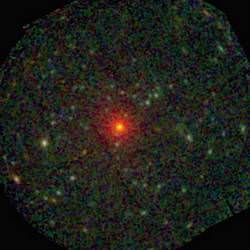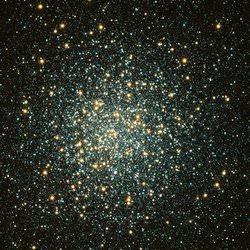
M3 – Credit: S. Kalfa and K. Honeycutt/Indiana University/WIYN/NAOA/NSF
Greetings fellow SkyWatchers! If you haven’t had a chance to observe Comet 73/P Schwassmann-Wachmann yet, right now is a good time as it sweeps through Coma Berenices. This week hosts galaxy studies and meteor showers, so enjoy darker skies – because…
Here’s what’s up!
Monday, April 24 – Before dawn, Venus and the Moon have a very close encounter. Today in 1970, China launched its first satellite – the beginnings of a national space program that later saw its first “taikonaut” in space.
Tonight, let’s use our binoculars and telescopes and take a break from galaxy quest. An alternative is to find one of the best northern hemisphere globular clusters – M3. You can locate M3 easily by identifying Cor Caroli (Alpha Canes Venatici) and Arcturus. Sweep your binoculars along a line halfway between the two and you will uncover this condensed beauty just east of Beta Comae. With added inches and magnification, the stars are out to play!
Discovered by Charles Messier on May 3, 1764, this condensed ball of approximately a half million stars is one of the oldest formations in our galaxy. At 35-40,000 light years distant, this awesome globular cluster spans 220 light years and is believed to be 10 billion years old.
Tuesday, April 25 – Today marks the 15th anniversary of the deployment of the Hubble Space Telescope (HST). While everyone in the astronomical community is aware of what this magnificent telescope “sees,” did you know that you can see it with just your eyes? The HST as a satellite can be tracked and observed. Visit the website Heavens-Above and enter your location. This will provide you with a list of times for visible satellite passes from your locale. Although you can’t see a detailed view of the satellite itself from Earth, it’s great fun to use binoculars and watch the Sun glint off all those highly polished surfaces!
Keep a watch on the skies tonight as the Mu Virginid meteor shower reaches its peak of 7 to 10 visible trails per hour. With the dark skies this evening, you might catch one of these medium speed meteors radiating from a point near the constellation of Libra.
Tonight is another “Missed Messier” – 8.9 magnitude NGC 3521. Often ignored by observers because of its isolated location in southern Leo, this tilted galaxy is a “must see” and fine representative of the grand spiral tradition. A delight even in small instruments, the galaxy reveals definite spiral structure in larger scopes and has been compared to M63 in overall structure.
To locate NGC 3521, start at Sigma Leonis and head almost three degrees south to 10.3 magnitude NGC 3640. Power up for a view of this oval-shaped elliptical beauty – then resume your quest for NGC 3521 by heading south-southwest another 1.5 degrees to 75 Leonis. Continue a little more than a finger-width south-southwest to 69 Leonis. NGC 3521 is located a finger-width due west of 69 Leonis.
Now that’s “star hopping’!
Wednesday, April 26 – If you’re up before dawn this morning, be sure to look for Mercury just slightly south of the Moon! On this date in 1920, the Shaply-Curtis debate raged in Washington DC on the nature and distance of spiral nebulae. Shaply contended that all such were part of one huge galaxy – the Milky Way, while Curtis maintained that they were distant galaxies all their own.
Thirteen years later on the same date, Arno Penzias was born. Penzias went on to become a Nobel Prize winner for his part in the discovery of cosmic microwave background radiation (CMBR) through the use of a simple horn-shaped antenna. Their discovery helped further our understanding of cosmology in ways that Shaply and Curtis could have never dreamed!
By 1850, Lord Rosse had used the 72 inch speculum-mirrored “Leviathon at Parsontown” (Birr Castle, Ireland) to catalogue fourteen previously indecipherable glowing clouds in deep space as “spiral nebulae.” The very first one resolved was originally a discovery of Charles Messier – found while chasing a comet on the night of October 13, 1773. That discovery, M51, had to wait 72 years until large reflecting telescopes unveiled its spiral form. It would take another 75 years before M51’s extragalactic nature became an indisputable fact!
Interestingly, observers have now become so accustomed to seeing spiral structure in brighter galaxies that even mid-sized scopes can see M51 – the Whirlpool Galaxy – as a “Grand Spiral.” Tonight see what Rosse saw for yourself.
Start in Ursa Major by locating Mizar (Zeta) and Alkaid (Eta), then rotate the line between these two 90 degrees south using Eta as the pivot. With the line oriented to the southwest, cut it in half. With good conditions and a mid-sized scope, you can be initiated into the mystery of the spiral nebulae – nebulae whose individual stars had to await the development of very large professional scopes and long-exposure photography to reveal their stellar nature to the questing human imagination!
Thursday, April 27 -Tonight is New Moon and a great time to “go deep!”
Start with M87 and fade a degree west for the and neighboring M86. These two massive galaxies can be revealed with almost any optical aid. They appear as a matched set of isolated ellipticals – but on an exceptional night, even small scopes will show much more to this region. The western member of the pair ? the M84 – appears slightly brighter and visibly smaller than the M86 yet the nucleus of M86 is broader, and less intensely brilliant. In large scopes, these two galaxies “leap” out of the eyepiece even at modest magnifications yet reveal no additional structure.
The most fascinating characteristic of the area becomes apparent when looking around M84 and M86. Within the same low power field, no less than five additional galaxies may be made out in a 6″ scope. Forming an easy triangle with the two Messiers, lies southern NGC 4388. At magnitude 11, this edge-on spiral shows a dim star-like core, and reveals classic edge-on structure at double the aperture. In the midst of the triangle formed by the two Messiers and NGC 4388, is 12th magnitude NGC 4387. This dim galaxy will only display a faintly stellar nucleus at mid-aperture, while larger scopes will see a very small face-on spiral with a bright nucleus. Just north of M86 is even dimmer NGC 4402. Like NGC 4388, NGC 4402 demands higher magnifications for positive identification through modest aperture scopes, and at large power you may notice a dust lane with the central core as a curved “bar” of light.
We’ve now gone as “deep” as we can. East of M86 are two brighter NGC galaxies – 4435 and 4438. Through a 6″ scope, NGC 4435 is easily picked out at low power with its simple star-like core and wispy round mantle. NGC 4438 is dim, but even with large aperture elliptical galaxies tend to be rather uninteresting creatures. The beauty of? NGC 4435 and? 4438 are simply their proximity to each other. NGC 4435 shows true elliptical structure, evenly illuminated and visibly faded toward the edges. But, 4438 is quite a different story! This elliptical is much more elongated. A highly conspicuous wisp of galactic material can be seen stretching back toward the brighter, nearby galaxy pair M84/86.
Friday, April 28 – Today was a busy day in astronomical history. Isaac Newton published his Principia in 1686. Newton was an obscure mathematician and early physicist who developed a new form of mathematics to describe planetary motion. In 1774, Francis Baily was born. Baily went on to revise star catalogs and explain the phenomenon now known as “Baily’s Beads” – seen at the start and end of a total solar eclipse. 1900 saw the birth of Jan Hendrick Oort, who quantified the Milky Way’s rotation and envisioned a vast, spherical area of comets outside the solar system now called the Oort Cloud. Today (in 1906) was also the birth date of Bart Jan Bok who studied the structure and dynamics of the Milky Way galaxy and like Oort had a class of objects – Bok Globules – named after him.
And the Milky Way is nowhere to be found! This is the reason we can see so many galaxies during the spring season. The great realm of galaxies we call the “Coma-Virgo Galaxy Cluster” has more in common with our own galaxy than simply not being hidden by the vast array of stars, gas, and dust. Our galaxy and its neighbors (making up the “Local Group”) are inexorably being drawn toward this massive assemblage of island universes based on forces first described by Isaac Newton. Yes, we are slipping. Slipping into a vast gravity well whose center is the giant elliptical galaxy M87!
For skywatchers, no equipment is necessary to enjoy the Alpha Bootid meteor shower tonight. Pull up a comfortable seat and face toward orange Arcturus climbing skyward in the east. These slow meteors have a fall rate of 6 to 10 per hour and leave very fine trails, making an evening of quiet contemplation most enjoyable.
Saturday, April 29 -Tonight see if you can spot the tender beginnings of the Moon after sunset. Observers take pleasure in sweeping the sky with small scopes and binoculars in hopes of finding the thinnest possible lunar crescent. This technique is also employed to turn up “the inferior planets” – Venus and Mercury. But both planets rise just before the Sun! If you rise early, look for them both about an hour before dawn.
Tonight let’s take advantage of dark sky and track down one of the most distant observable studies in the Universe that can be seen in amateur equipment – 2 billion light year distant quasar 3C273. You will need aperture – at least 8″ – and a star chart showing the detailed field in which the quasar is located. This study is so distant that we can only see its super-luminous radiant core looking precisely like a faint 13th magnitude blue star!
Start by re-locating M61 and drop 2.5 degrees southeast for the approximate location of a quasar 3c273 – the incredibly luminous core of a brilliant galaxy possessed of a super-supermassive black hole of more than 500 million solar masses. A galaxy whose brilliance is such that it would almost outshine our own Sun were it placed 33 light years (1 parsec) away and outshine all the light of the Milky Way galaxy 100 times over!
To verify 3C273, you will need a detailed star chart. But knowing you’re looking at one of the most distant objects an amateur can see makes it worth the hunt!
Sunday, April 30 – Karl Frederich Gauss was born on this day in 1777. Known as the “Prince of Mathematics,” Gauss contributed to the field of astronomy in many ways – from computing asteroid orbits to inventing the heliotrope. Out of Gauss’ many endeavors, he is most recognized for his work in magnetism. We understand the term “gauss” as a magnetic unit – a refrigerator magnet carries about 100 gauss while an average sunspot might go up to a 4000. On the most extreme ends of the magnetic scale, the Earth produces about 0.5 gauss at its poles, while a magnetar can produce as much as 10 to the 15th power in gauss units!
While we cannot directly observe a magnetar, those living in the Southern Hemisphere can view a region of the sky where magnetars are known to exist – the Large Magellanic Cloud. Located in the constellation of Dorado, this unaided eye gem is visible even during full moonlight. It’s stuffed with wonderful features such as the Tarantula Nebula – the largest diffuse nebula known in the Universe. It also holds many star clusters, so get out those telescopes and binoculars and explore for your friends in the northern hemisphere!
May all your journeys be at light speed… ~Tammy Plotner with Jeff Barbour.
